The
Warhol’s
Artist Educators Help Teachers Teach
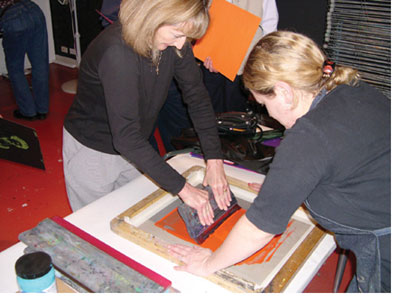
To say that Andy Warhol was a unique
guy is, of course, an understatement. But his distinctly
different approach
to life and art has given The Andy Warhol Museum’s
education department an equally unique challenge: how
to translate Warhol’s distinctiveness into
programs that use his art as a means of teaching
students to
think in broader contexts. “
It’s less about teaching people how to do a
Campbell’s
Soup can and more about teaching them about the framework
of thinking,” says Jessica Gogan, The Warhol’s
assistant director for education and interpretation. “It’s
not the ‘what’ of Warhol’s art
that we teach, it’s the ‘how’ of
his creative process and using it as a form of expression.” Gogan
notes that people in the education field liken this
learning concept to the adage, “Give me a fish
and I eat for one day; teach me how to fish and I
can eat forever.”
Warhol’s art provides
the jumping-off point to teach the creative process
and develop students’ skills.
To that end, The Warhol’s education department
has developed a variety of programs to help teachers
stimulate their students’ critical, cultural,
and aesthetic thinking processes, including a newsletter
titled Education News, professional development seminars,
teacher open houses, and learning labs. And,
in addition to providing a building full of stimulating
art and a knowledgeable staff of artist educators,
The Warhol also offers the Mellon Education Resource
Center, which is an interdisciplinary library and
resource center.
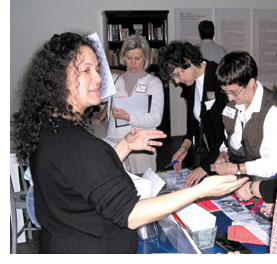 The open houses that are held
each fall give teachers an introduction to The
Warhol’s
resources. The informal wine-and-snack receptions
create a relaxed, social atmosphere in which teachers
can
see for themselves the instructional opportunities
they’ll find at The Warhol. The open houses that are held
each fall give teachers an introduction to The
Warhol’s
resources. The informal wine-and-snack receptions
create a relaxed, social atmosphere in which teachers
can
see for themselves the instructional opportunities
they’ll find at The Warhol.
The professional
development programs help teachers build curricula
and foster creativity among students.
And teachers who are accepted into the museum’s
Learning Lab help develop and test curriculum
materials and contribute to the museum’s
newsletter.
A core focus of the museum’s
education resources is ensuring that all materials
meet the loocal, state,
and national art education standards as well
as core standards across curricula. There are
numerous arts
standards that are all divided into four overarching
categories: production; performance and exhibition;
historical and cultural contexts; critical
response; and aesthetic response.
“
For example, the state arts standard for critical response
is designed to make sure that students can engage with
artworks, look at them critically, and write their
own critical responses,” Gogan says. In 2002-2003,
using the exhibition, Americanisms: Shaping
Art and Culture in the 1950s as a springboard, the education
department developed a learning unit and model to fully
address critical rsponse in the classroom. In that
case, teachers worked with The Warhol’s artist
educators to develop content for the annual Education
News publication, which provides teachers with source
material, lesson plans, and cross-curriculum activity
ideas. Teachers and staff then field-tested the unit;
and the result will be featured as part of the museum’s
online kindergarten-through-12th grade teaching curriculum.
“
We’ve been doing these newsletters and offering
expanded content and resource material within a kind
of learning unit framework so teachers can follow it
as if it were a recipe. Or they can pick and choose
what they’d like to use,” Gogan says.
“
Overall, what we’re trying to do,” she
adds, “is to develop model frameworks
using Warhol’s
art that we and others can use to teach critical
response and other core standards.”
While
the museum’s programming and resources
have proven very successful, the initiatves
are still fairly new. Gogan says she looks
forward to a time
10 years or so down the road when educators
can look back at these programs and determine
just what their
impact has been on the students they taught.
In the meantime, she and her staff will continue
working to
make The Warhol as user-friendly as possible—for
both teachers and the students whose minds
they help mold.
Teacher programs and resources are supported in part
by The Grable Foundation and the W.L.S. Spencer Foundation.
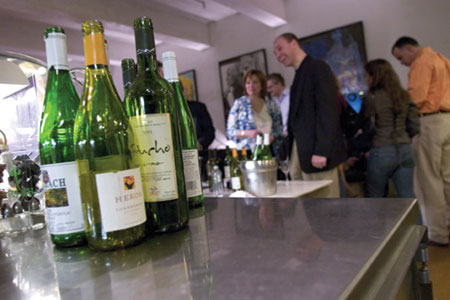
Sample Great Wine at The Warhol
Just as Andy Warhol
had a knack for plucking away at the art world’s highbrow, The Warhol
Café’s monthly wine-tasting sessions squeeze
the snobbery right out of grape appreciation.
The tastings, which began about a year and a half
ago, give participants opportunities to sample products
they can’t buy in Pennsylvania’s state
stores. The selections are chosen and supplied by Dreadnought
Wines in the Strip District and accompanied by hors
d’oeuvres created by Café Manager Chris
Noonan, an employee of Café operator Big Burrito
Restaurant Group.
“
The Café is a neat, cozy little environment.
It’s a unique atmosphere to have a wine-tasting,” says
Noonan. The relaxed, unpretentious setting and the
scale of wines presented—most are under $12—gives
participants the feeling that they’ve discovered
a cool little secret.
“
Some people are amazed how good the $8.50 bottles
are,” says
Noonan, who praises bargain-priced South American
and Australian varieties.
Tastings are held the
last Friday of each month
as part of the museum’s Good Fridays programming.
Before each session, Noonan and Dreadnought owner
Michael Gonze talk about tasting themes. Noonan
likes to highlight
geographical regions.
“
I want to do a Spanish tasting, or I want to do
an Italian tasting,” he says. “From
those discussions, Mike gives me a list of what
he’s
going to serve. Then I come up with the food.”
Gonze
usually picks two reds and two whites, though
lately he’s been throwing in a fifth—a
rose—to help dispel prejudices against
the pinks. Noonan reports blends are also getting
hotter
now;
they’re even attracting new wine drinkers
who weren’t lured by reds or whites. As
more evidence that wine-drinking cycles through
trends,
Noonan says
chardonnays are on their way out; sauvignon blancs
and pinot grigios are in.
Once the wines are
selected, Noonan creates his menu. He keeps
it simple, partly for budget reasons,
and
partly not to overwhelm the wines. He always
includes “three or four nice cheeses,” along
with charcuterie-style meats, a spread such as
a pate or tapenade, and lots of crackers and
crostini. Noonan
often turns to his colleagues at Casbah, another
Big Burrito restaurant, for food suggestions
and preparation.
Because the Café lacks a proper kitchen,
he relies on his former co-workers to create
those customized
spreads. He’s also a popular customer in
the Strip.
“
They like me at Penn-Mac. They know when I
walk in, something’s going on,” Noonan
says with a laugh. He says the tastings have
helped create more
buzz about the museum and Café, as well
as Dreadnought’s
wines. They’ve also increased the museum’s
profile as a place to hold private events,
including tastings.
Art, wine, and food belong
together, according to Noonan, and as far as
he’s concerned,The Warhol provides
the perfect setting for all three.
The $12
wine-tasting fee includes a $5 museum admission
charge. Walk-ins
are welcome.
the warhol: The Place for Performance Art
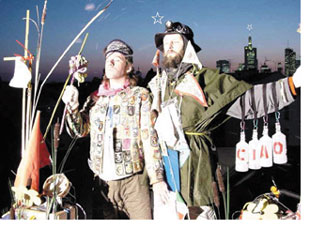 Lone
Twin Lone
Twin
The goal of any museum is to lure visitors inside
to inspect
its contents. But a few years ago, The Andy
Warhol Museum declared its intent to reach far
beyond its function as a repository of artistic images.
With
the mission statement, “The Warhol: More than
a Museum,” the museum began turning its North
Shore building into a place of inspiration; a place
to find the unexpected, and to be intrigued—and
entertained—by it. The idea was to break out of
the realm of visual art and into exploration of all
other art forms, including
performance, as Warhol himself had done. “Since
Warhol was so prolific and worked in so many realms —his
Factory, in essence, was a big performance arts space—there’s
a really obvious connection for live art in the museum,” says
Assistant Curator for Performance Ben Harrison.
Using
The Warhol’s already-existing happy hours
as a jumping-off point, staffers did a little brainstorming
and came up with a performance art series they
dubbed Off the Wall. That was four successful seasons
ago.
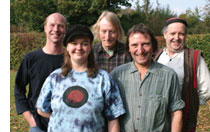 The
Warhol’s Director, Thomas Sokolowski,
was the visionary behind the performance art
series that
began as a collaboration with Performance Space
(P.S.) 122 in New York City, the preeminent national
pioneer
in performance art. Sokolowski invited Mark Russell,
then-director of P.S. 122, to lead the way for
The Warhol to get involved in presenting performances. The
Warhol’s Director, Thomas Sokolowski,
was the visionary behind the performance art
series that
began as a collaboration with Performance Space
(P.S.) 122 in New York City, the preeminent national
pioneer
in performance art. Sokolowski invited Mark Russell,
then-director of P.S. 122, to lead the way for
The Warhol to get involved in presenting performances.
The Incredible String Band Of course, generating live art in a museum designed
for anything but presented a challenge. P.S.
122 was given the challenge of coming up with
performances
that would work in the museum’s non-traditional
spaces and be low-impact both economically
and to the valuable art works—which,
despite the series title, were not about to
come off
the walls.
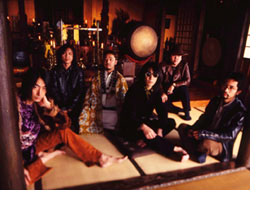 Ghost Ghost
But Russell and Sokolowski dove
right in and presented some of the most well-known
and infamous
performance
art in the world in the very first season.
In fact, Karen Finley was one of the first
to perform
at
The Warhol. She was also one of the headline-grabbing
NEA 4 who sued the National Endowment of the
Arts, claiming
its consideration of “decency” when
awarding grants amounted to censorship. Her
show involved throwing
honey around and rolling in it. But staffers
were determined to make the show go on, so
they covered Warhol’s
paintings in plastic and exhaled when she finished. In
January, the Off the Wall program will begin
its fifth season, which will run through May.
It will
include more unique and titillating performances
in
both The Warhol’s traditional and non-traditional spaces, and also
will take the program one step further by presenting at least one piece
that will
take place outside The Warhol’s walls altogether. Antony and the
Johnsons, who performed at The Warhol in 2001, are expected to perform
a variation of a
new work that involves a collaboration with video artist Charles Atlas
at the Hazlett Theater, the Pittsburgh Public Theater’s former
North Side home. There’s also talk of collaboration with the African-American
Cultural Center, whose debut season will begin this fall.
 In addition
to offering its annual Off the Wall program, The Warhol presents a
wide variety of distinctive, and often provocative,
live art performances
as part of its Good Fridays program. The following is a sampling
of live art performances
through October. In addition
to offering its annual Off the Wall program, The Warhol presents a
wide variety of distinctive, and often provocative,
live art performances
as part of its Good Fridays program. The following is a sampling
of live art performances
through October.
Maura Nguyen Donohue
Upcoming Live Art Performances
Sep. 24: Japanese psychedelic-rock collective, Ghost,
will perform at Good Fridays at 7 p.m. Hailing from
Tokyo, the band is known for playing its improvisational
style of music in unique locations—Buddhist
temples, churches, subway stations, fields, caves—and
now, The Warhol theater. California-based band Six
Organs of Admittance will also perform. Tickets are
$10 and are available in advance by calling 412.237.8300.
Oct. 9: British performance artists
Gregg Whelan and Gary Winters—a.k.a. lone
twin—will
perform Walk with Me, Walk with Me, Will Somebody
Please Walk
with Me, at The Warhol at 2 p.m. and 5 p.m. as part
of the Pittsburgh International Festival of Firsts.
Walk with Me is a quirky performance with an oddball,
English sense of humor that appeals to a wide audience.
Tickets are $20, $10 for students and members, and
can be purchased by calling 412.456.6666 or online
at www.pgharts.org/PIFOF.
Oct. 10: lone twin also
will be performing a separate outdoor piece at 2
p.m. entitled, Clouds Over The
Warhol. Audience members will gather in front of
The Warhol
for the beginning of the piece and walk to the
Mattress Factory with lone twin as they attempt to
make “clouds” from
the water contained in their bodies. This is a
free performance.
Oct. 22: The Warhol and The Calliope
Folk Music
Society will present 1960s legends and psychedelic-folk
music
pioneers The Incredible String Band (ISB) for
an intimate performance at the Hazlett Theater as
part of their
first U.S. tour in 30 years. Most noted for their
unique and eclectic sound, blending Celtic folk
melodies with
a variety of Middle Eastern and Asian instrumentation,
ISB profoundly influenced the development of
popular music in the ‘60s. Performance begins at
8 p.m. at the Hazlett Theater on the North Side.
Tickets are
$15, $10 for students, and are available beginning
September 22 by calling 412.237.8300.
The International Festival of Firsts is a project
of The Pittsburgh Cultural Trust in association with
the Carnegie Mellon School of Drama. For three weeks
in October, seven international dance, theater, visual
art, and opera companies will present work never before
seen in the United States.
Funding for The Warhol’s
performing arts programming has been provided by
the James H. Beal Fund, the Jack
and Tally McKee Memorial Fund, and the Samuel and Carrie
Arnold Weinhaus Memorial Fund of the Pittsburgh Foundation.
Back to Contents |